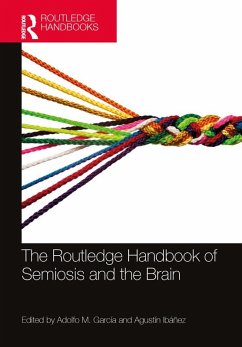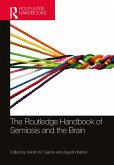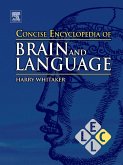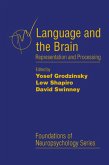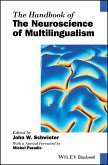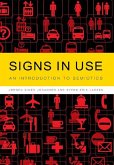The Routledge Handbook of Semiosis and the Brain (eBook, PDF)
Redaktion: García, Adolfo M.; Ibáñez, Agustín
46,95 €
46,95 €
inkl. MwSt.
Sofort per Download lieferbar

23 °P sammeln
46,95 €
Als Download kaufen

46,95 €
inkl. MwSt.
Sofort per Download lieferbar

23 °P sammeln
Jetzt verschenken
Alle Infos zum eBook verschenken
46,95 €
inkl. MwSt.
Sofort per Download lieferbar
Alle Infos zum eBook verschenken

23 °P sammeln
The Routledge Handbook of Semiosis and the Brain (eBook, PDF)
Redaktion: García, Adolfo M.; Ibáñez, Agustín
- Format: PDF
- Merkliste
- Auf die Merkliste
- Bewerten Bewerten
- Teilen
- Produkt teilen
- Produkterinnerung
- Produkterinnerung

Bitte loggen Sie sich zunächst in Ihr Kundenkonto ein oder registrieren Sie sich bei
bücher.de, um das eBook-Abo tolino select nutzen zu können.
Hier können Sie sich einloggen
Hier können Sie sich einloggen
Sie sind bereits eingeloggt. Klicken Sie auf 2. tolino select Abo, um fortzufahren.

Bitte loggen Sie sich zunächst in Ihr Kundenkonto ein oder registrieren Sie sich bei bücher.de, um das eBook-Abo tolino select nutzen zu können.
This handbook introduces neurosemiotics, a pluralistic framework to reconsider semiosis as an emergent phenomenon at the interface of biology and culture.
- Geräte: PC
- mit Kopierschutz
- eBook Hilfe
Andere Kunden interessierten sich auch für
![The Routledge Handbook of Semiosis and the Brain (eBook, ePUB) The Routledge Handbook of Semiosis and the Brain (eBook, ePUB)]() The Routledge Handbook of Semiosis and the Brain (eBook, ePUB)46,95 €
The Routledge Handbook of Semiosis and the Brain (eBook, ePUB)46,95 €![Concise Encyclopedia of Brain and Language (eBook, PDF) Concise Encyclopedia of Brain and Language (eBook, PDF)]() Concise Encyclopedia of Brain and Language (eBook, PDF)101,95 €
Concise Encyclopedia of Brain and Language (eBook, PDF)101,95 €![Language and the Brain (eBook, PDF) Language and the Brain (eBook, PDF)]() Language and the Brain (eBook, PDF)96,95 €
Language and the Brain (eBook, PDF)96,95 €![The Acoustic Self in English Modernism and Beyond (eBook, PDF) The Acoustic Self in English Modernism and Beyond (eBook, PDF)]() Zoltan VargaThe Acoustic Self in English Modernism and Beyond (eBook, PDF)0,00 €
Zoltan VargaThe Acoustic Self in English Modernism and Beyond (eBook, PDF)0,00 €- -25%11
![Semantik (eBook, PDF) Semantik (eBook, PDF)]() Daniel GutzmannSemantik (eBook, PDF)14,99 €
Daniel GutzmannSemantik (eBook, PDF)14,99 € ![The Handbook of the Neuroscience of Multilingualism (eBook, PDF) The Handbook of the Neuroscience of Multilingualism (eBook, PDF)]() The Handbook of the Neuroscience of Multilingualism (eBook, PDF)36,99 €
The Handbook of the Neuroscience of Multilingualism (eBook, PDF)36,99 €![Signs in Use (eBook, PDF) Signs in Use (eBook, PDF)]() Jørgen Dines JohansenSigns in Use (eBook, PDF)40,95 €
Jørgen Dines JohansenSigns in Use (eBook, PDF)40,95 €-
-
-
This handbook introduces neurosemiotics, a pluralistic framework to reconsider semiosis as an emergent phenomenon at the interface of biology and culture.
Dieser Download kann aus rechtlichen Gründen nur mit Rechnungsadresse in A, B, BG, CY, CZ, D, DK, EW, E, FIN, F, GR, HR, H, IRL, I, LT, L, LR, M, NL, PL, P, R, S, SLO, SK ausgeliefert werden.
Produktdetails
- Produktdetails
- Verlag: Taylor & Francis eBooks
- Seitenzahl: 430
- Erscheinungstermin: 14. November 2022
- Englisch
- ISBN-13: 9781000728736
- Artikelnr.: 65847865
- Verlag: Taylor & Francis eBooks
- Seitenzahl: 430
- Erscheinungstermin: 14. November 2022
- Englisch
- ISBN-13: 9781000728736
- Artikelnr.: 65847865
- Herstellerkennzeichnung Die Herstellerinformationen sind derzeit nicht verfügbar.
Adolfo M. García specializes in the neuroscience of language and communication. He serves as Director of the Cognitive Neuroscience Center (UdeSA, Argentina), Senior Atlantic Fellow at the Global Brain Health Institute (UCSF, USA), Associate Researcher at USACH (Chile), Director of Language Science at Redenlab, and Researcher at CONICET (Argentina). Dr. García leads research projects in more than ten countries across the globe. He has more than 200 publications, including works in top ten journals. His scientific contributions have been recognized by various awards and distinctions. Agustín Ibáñez works on global approaches to dementia and social, cognitive, and affective neuroscience. He is Director of the Latin American Brain Health Institute (BrainLat) and Full Professor at the CSCN (Universidad Adolfo Ibáñez, Chile); and Associate Research Professor and Group Leader of Predictive Brain Health Modelling Group (TCD, Ireland). Dr Ibáñez has over 300 publications, including works in top ten journals. His intense work has helped Latin American translational neuroscience by establishing a framework to engage scientists through internships, workshops, master's and PhD programs, organizing educational activities for the health community, and focusing on cognitive neuroscience, among others.
Acknowledgements
Semiosis, brain, and context: The unmet need for a transdisciplinary
framework (A. M. García & A. Ibáñez)
PART 1: PROLEGOMENA TO NEUROSEMIOTICS
1. Neurosemiotics: A brief history of its development and key concerns (K.
Kull & D. Favareau)
2. Steps to a semiotic cognitive neuroscience (T. Deacon)
3. An active inference approach to semiotics: A variational theory of signs
(A. Milette-Gagnon, S. P. L. Veissière, K. J. Friston, & M. J. D. Ramstead)
4. Experimental semiotics: Past, present, and future (J. Nölle & B.
Galantucci)
5. Beyond the human animal: Towards a cross-species neurosemiotics (M.
Tønnessen)
PART 2: LANGUAGE AND ITS PATHWAYS TO MEANING
6. Neural bases of multimodal semantics (M. Visser)
7. Embodied mechanisms and the shaping of semantics (G. Buccino)
8. The figurative brain (V. Cuccio)
9. Pharmacological modulation of meaning attribution (E. Tagliazucchi)
10. How grammar means (M. de Vega)
11. Discourse and the brain: Capturing meaning in the wild (N. Riccardi &
R. H. Desai)
12. Words, meanings, and the bilingual brain (N. del Maschio, J. Abutalebi,
& D. Perani)
13. How do sign languages mean? (R. Campbell)
PART 3: THE NEUROSEMIOTICS OF SOCIAL DYNAMICS
14. Empathy, meaning, and the human brain (K. Lehmann & P. Kanske)
15. Biological bases of moral cognition and their role in the construal of
meaning (S. Baez)
16. The neurosemiotics of social interaction: Insights from second-person
neuroscience (L. Schilbach)
17. Joint epistemic engineering: The neglected process in human
communication (A. Stolk, J. Banáková, & I. Toni)
18. Towards a neurosemiotics of friendship (C. Emmeche)
19. Neurosemiotics and ideology: A linguistic view (A. Lukin & D. Butt)
20. The interplay of culture, religion, and biology (J. Y. Sasaki & H. I.
Pearson)
PART 4: FURTHER SEMIOTIC DOMAINS
21. What makes us human? Face identity recognition (B. Rossion)
22. Musical signs and the human organism (A. M. Belfi)
23. The meaning of tools: The pragmatic value of semantic knowledge (F.
Osiurak, J. Baumard, C. Merck, & M. Lesourd)
24. Interpreting the signals within: Meaning and prediction during
interoception (R. Smith & S. S. Khalsa)
25. The hierarchical semantics of self (G. Northoff & D. Gorini)
Semiosis, brain, and context: The unmet need for a transdisciplinary
framework (A. M. García & A. Ibáñez)
PART 1: PROLEGOMENA TO NEUROSEMIOTICS
1. Neurosemiotics: A brief history of its development and key concerns (K.
Kull & D. Favareau)
2. Steps to a semiotic cognitive neuroscience (T. Deacon)
3. An active inference approach to semiotics: A variational theory of signs
(A. Milette-Gagnon, S. P. L. Veissière, K. J. Friston, & M. J. D. Ramstead)
4. Experimental semiotics: Past, present, and future (J. Nölle & B.
Galantucci)
5. Beyond the human animal: Towards a cross-species neurosemiotics (M.
Tønnessen)
PART 2: LANGUAGE AND ITS PATHWAYS TO MEANING
6. Neural bases of multimodal semantics (M. Visser)
7. Embodied mechanisms and the shaping of semantics (G. Buccino)
8. The figurative brain (V. Cuccio)
9. Pharmacological modulation of meaning attribution (E. Tagliazucchi)
10. How grammar means (M. de Vega)
11. Discourse and the brain: Capturing meaning in the wild (N. Riccardi &
R. H. Desai)
12. Words, meanings, and the bilingual brain (N. del Maschio, J. Abutalebi,
& D. Perani)
13. How do sign languages mean? (R. Campbell)
PART 3: THE NEUROSEMIOTICS OF SOCIAL DYNAMICS
14. Empathy, meaning, and the human brain (K. Lehmann & P. Kanske)
15. Biological bases of moral cognition and their role in the construal of
meaning (S. Baez)
16. The neurosemiotics of social interaction: Insights from second-person
neuroscience (L. Schilbach)
17. Joint epistemic engineering: The neglected process in human
communication (A. Stolk, J. Banáková, & I. Toni)
18. Towards a neurosemiotics of friendship (C. Emmeche)
19. Neurosemiotics and ideology: A linguistic view (A. Lukin & D. Butt)
20. The interplay of culture, religion, and biology (J. Y. Sasaki & H. I.
Pearson)
PART 4: FURTHER SEMIOTIC DOMAINS
21. What makes us human? Face identity recognition (B. Rossion)
22. Musical signs and the human organism (A. M. Belfi)
23. The meaning of tools: The pragmatic value of semantic knowledge (F.
Osiurak, J. Baumard, C. Merck, & M. Lesourd)
24. Interpreting the signals within: Meaning and prediction during
interoception (R. Smith & S. S. Khalsa)
25. The hierarchical semantics of self (G. Northoff & D. Gorini)
Acknowledgements
Semiosis, brain, and context: The unmet need for a transdisciplinary
framework (A. M. García & A. Ibáñez)
PART 1: PROLEGOMENA TO NEUROSEMIOTICS
1. Neurosemiotics: A brief history of its development and key concerns (K.
Kull & D. Favareau)
2. Steps to a semiotic cognitive neuroscience (T. Deacon)
3. An active inference approach to semiotics: A variational theory of signs
(A. Milette-Gagnon, S. P. L. Veissière, K. J. Friston, & M. J. D. Ramstead)
4. Experimental semiotics: Past, present, and future (J. Nölle & B.
Galantucci)
5. Beyond the human animal: Towards a cross-species neurosemiotics (M.
Tønnessen)
PART 2: LANGUAGE AND ITS PATHWAYS TO MEANING
6. Neural bases of multimodal semantics (M. Visser)
7. Embodied mechanisms and the shaping of semantics (G. Buccino)
8. The figurative brain (V. Cuccio)
9. Pharmacological modulation of meaning attribution (E. Tagliazucchi)
10. How grammar means (M. de Vega)
11. Discourse and the brain: Capturing meaning in the wild (N. Riccardi &
R. H. Desai)
12. Words, meanings, and the bilingual brain (N. del Maschio, J. Abutalebi,
& D. Perani)
13. How do sign languages mean? (R. Campbell)
PART 3: THE NEUROSEMIOTICS OF SOCIAL DYNAMICS
14. Empathy, meaning, and the human brain (K. Lehmann & P. Kanske)
15. Biological bases of moral cognition and their role in the construal of
meaning (S. Baez)
16. The neurosemiotics of social interaction: Insights from second-person
neuroscience (L. Schilbach)
17. Joint epistemic engineering: The neglected process in human
communication (A. Stolk, J. Banáková, & I. Toni)
18. Towards a neurosemiotics of friendship (C. Emmeche)
19. Neurosemiotics and ideology: A linguistic view (A. Lukin & D. Butt)
20. The interplay of culture, religion, and biology (J. Y. Sasaki & H. I.
Pearson)
PART 4: FURTHER SEMIOTIC DOMAINS
21. What makes us human? Face identity recognition (B. Rossion)
22. Musical signs and the human organism (A. M. Belfi)
23. The meaning of tools: The pragmatic value of semantic knowledge (F.
Osiurak, J. Baumard, C. Merck, & M. Lesourd)
24. Interpreting the signals within: Meaning and prediction during
interoception (R. Smith & S. S. Khalsa)
25. The hierarchical semantics of self (G. Northoff & D. Gorini)
Semiosis, brain, and context: The unmet need for a transdisciplinary
framework (A. M. García & A. Ibáñez)
PART 1: PROLEGOMENA TO NEUROSEMIOTICS
1. Neurosemiotics: A brief history of its development and key concerns (K.
Kull & D. Favareau)
2. Steps to a semiotic cognitive neuroscience (T. Deacon)
3. An active inference approach to semiotics: A variational theory of signs
(A. Milette-Gagnon, S. P. L. Veissière, K. J. Friston, & M. J. D. Ramstead)
4. Experimental semiotics: Past, present, and future (J. Nölle & B.
Galantucci)
5. Beyond the human animal: Towards a cross-species neurosemiotics (M.
Tønnessen)
PART 2: LANGUAGE AND ITS PATHWAYS TO MEANING
6. Neural bases of multimodal semantics (M. Visser)
7. Embodied mechanisms and the shaping of semantics (G. Buccino)
8. The figurative brain (V. Cuccio)
9. Pharmacological modulation of meaning attribution (E. Tagliazucchi)
10. How grammar means (M. de Vega)
11. Discourse and the brain: Capturing meaning in the wild (N. Riccardi &
R. H. Desai)
12. Words, meanings, and the bilingual brain (N. del Maschio, J. Abutalebi,
& D. Perani)
13. How do sign languages mean? (R. Campbell)
PART 3: THE NEUROSEMIOTICS OF SOCIAL DYNAMICS
14. Empathy, meaning, and the human brain (K. Lehmann & P. Kanske)
15. Biological bases of moral cognition and their role in the construal of
meaning (S. Baez)
16. The neurosemiotics of social interaction: Insights from second-person
neuroscience (L. Schilbach)
17. Joint epistemic engineering: The neglected process in human
communication (A. Stolk, J. Banáková, & I. Toni)
18. Towards a neurosemiotics of friendship (C. Emmeche)
19. Neurosemiotics and ideology: A linguistic view (A. Lukin & D. Butt)
20. The interplay of culture, religion, and biology (J. Y. Sasaki & H. I.
Pearson)
PART 4: FURTHER SEMIOTIC DOMAINS
21. What makes us human? Face identity recognition (B. Rossion)
22. Musical signs and the human organism (A. M. Belfi)
23. The meaning of tools: The pragmatic value of semantic knowledge (F.
Osiurak, J. Baumard, C. Merck, & M. Lesourd)
24. Interpreting the signals within: Meaning and prediction during
interoception (R. Smith & S. S. Khalsa)
25. The hierarchical semantics of self (G. Northoff & D. Gorini)
